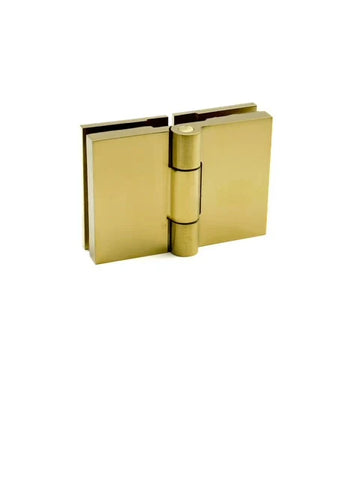
Glass to glass hinges are an essential component in modern shower enclosure hardware, particularly in the design and functionality of frameless showers. These precision-engineered fixtures connect two glass panels, allowing seamless movement while maintaining a clean, minimalistic look. As bathroom design trends continue to shift towards open, elegant, and easy-to-clean layouts, the role of high-quality shower hinges becomes increasingly critical. This article explores what glass to glass hinges are, their benefits, selection tips, available types, and helps homeowners, designers, and contractors identify the best options for their next project.
What Are Glass to Glass Hinges?
Glass to glass hinges are specially designed mechanical fittings used to connect one glass panel to another in a frameless configuration. Unlike traditional hinges that attach to a wall or frame, these hinges are mounted directly between two pieces of tempered glass, typically at 90° or 135° angles.
They’re commonly used in frameless shower enclosures, a popular choice in contemporary bathroom design. The clean, frameless look is not only aesthetically pleasing but also provides practical benefits like reduced mold buildup and easier maintenance.
These hinges are typically made from durable materials such as stainless steel, brass, or zinc alloy and come in a variety of hinge finishes—from polished chrome and brushed nickel to matte black—to suit different interior styles. Their function is both structural and aesthetic, offering reliable support while preserving the modern, transparent look of the glass.

Benefits of Using Glass to Glass Hinges in Showers
Choosing glass to glass hinges offers multiple benefits, both functional and visual. Below are ten key advantages:
1. Frameless Aesthetic Appeal
- Description: These hinges support a sleek, minimalistic look by eliminating the need for bulky frames.
- Example: A frameless shower with glass-to-glass 135° hinges creates a clean, spa-like ambiance.
2. Maximized Transparency
- Description: Since hinges are mounted directly between glass panels, visibility is uninterrupted.
- Example: Perfect for small bathrooms where visual openness is essential.
3. Improved Hygiene
- Description: Frameless setups using these hinges reduce spots where dirt and mold can accumulate.
- Example: No metal corners for grime buildup as seen in framed enclosures.
4. Enhanced Durability
- Description: Made from corrosion-resistant materials, glass to glass hinges offer long-lasting performance.
- Example: Stainless steel hinges are ideal for humid shower environments.
5. Smooth Operation
- Description: High-quality hinges provide seamless opening and closing of shower doors.
- Example: Soft-close models offer a gentle stop mechanism for user comfort.
6. Flexibility in Design
- Description: Available in 90°, 135°, and 180° formats for different layout needs.
- Example: Corner shower installations benefit from 135° hinges.
7. Load-Bearing Capacity
- Description: Strong hinges can support heavy tempered glass panels up to 50 kg or more.
- Example: Ideal for luxurious, oversized glass doors.
8. Customization Options
- Description: Available in multiple sizes, finishes, and opening mechanisms.
- Example: Matte black hinges paired with dark grout for a modern industrial look.
9. Water Sealing Compatibility
- Description: Works well with shower seals to prevent water leakage.
- Example: Used alongside magnetic or rubber seals in wetroom-style enclosures.
10. Increased Property Value
- Description: Frameless, high-end finishes enhance overall bathroom appeal.
- Example: A well-designed shower enclosure can raise resale value by improving bathroom aesthetics.
Steps to Choose the Right Glass to Glass Hinges
Selecting the right shower hinges involves more than aesthetics. Here are 8 essential steps:
1. Assess Glass Thickness
- Description: Measure whether your glass is 8mm, 10mm, or 12mm thick.
- Practical Tip: Always match hinge specifications to your glass thickness.
2. Define Opening Angle
- Description: Decide if your hinge needs to open 90°, 135°, or 180°.
- Practical Tip: 135° hinges are ideal for neo-angle showers.
3. Choose Finish Wisely
- Description: Align hinge finish with other bathroom fixtures.
- Practical Tip: Brushed nickel suits most modern bathrooms.
4. Evaluate Weight Capacity
- Description: Confirm the hinge can support your glass door’s weight.
- Practical Tip: Look for hinges rated 30-50kg for single-panel doors.
5. Decide on Self-Close or Not
- Description: Some hinges offer a self-closing feature.
- Practical Tip: Self-close is great for reducing water splash but not ideal if users need wide access.
6. Check Water Resistance
- Description: Ensure the hinge resists corrosion in humid environments.
- Practical Tip: Prioritize marine-grade stainless steel.
7. Verify Installation Type
- Description: Glass-to-glass vs. wall-mounted hinges vary in mounting methods.
- Practical Tip: Glass-to-glass is better for center glass doors or corner enclosures.
8. Review Certification
- Description: Look for CE or ISO-certified products for safety and quality.
- Practical Tip: Always buy from reputable suppliers like Quality Glass Fittings.

Types of Glass to Glass Hinges for Showers
Glass to glass hinges are available in multiple configurations to suit different shower enclosure hardware designs:
- 90° Hinges: Common in L-shaped corner installations; allows perpendicular glass connections.
- 135° Hinges: Perfect for neo-angle or pentagonal enclosures where panels meet at an obtuse angle.
- 180° Hinges: Used for inline glass panels; enables full opening without obstruction.
- Pivot Hinges: These rotate at a central point at the top and bottom of the door rather than the side.
- Self-Closing Hinges: Contains internal springs that bring the door back to the closed position.
- Beveled Edge Hinges: Designed to complement the angled edge of custom-cut glass.
Hinge materials include stainless steel, solid brass, and zinc alloys—each selected for durability and resistance to corrosion. Popular hinge finishes include polished chrome, matte black, antique brass, and brushed nickel, matching the evolving trends in bathroom design.
Comparison Table of Glass to Glass Hinge Types
| Hinge Type | Features | Advantages | Disadvantages |
|---|---|---|---|
| 90° Glass to Glass | Connects perpendicular glass panels | Strong and standard for corner showers | Not suitable for non-right angles |
| 135° Glass to Glass | Connects glass at obtuse angles | Ideal for neo-angle designs | May require precise measurement |
| 180° Glass to Glass | Joins inline glass panels | Provides seamless alignment | Needs very accurate glass cuts |
| Pivot Hinge | Rotates at top and bottom | Modern aesthetic and space-saving | Requires specific floor/wall setup |
| Self-Closing Hinge | Spring-loaded for auto-close | Prevents door from staying open | May wear over time with frequent use |
Installation Tips for Glass to Glass Hinges in Frameless Showers
Proper installation of glass to glass hinges is critical to achieving both the functional performance and aesthetic goals of a frameless shower. Even the best-quality shower enclosure hardware can fail if not installed correctly. Below are practical steps and considerations for a successful hinge installation:
Begin by measuring the thickness of each glass panel—most hinges sold by Quality Glass Fittings support 8–10 mm thick tempered glass. Ensure that glass panels are cut precisely and cleanly, with polished edges for safe handling and hinge contact. Before mounting, clean the surface thoroughly to remove any debris or glass particles that could affect adhesion or alignment.
Mark the hinge placement carefully, keeping equal spacing between the top and bottom hinges for even load distribution. Typically, two hinges are used for standard-height panels, but heavier doors may require a third. Use soft plastic or rubber gaskets between the hinge and the glass to prevent damage and ensure grip. If your chosen hinge is a self-centering model, as available on the Quality Glass Fittings website, verify that the spring mechanism is correctly oriented before tightening.
When securing the hinge, apply even torque to the fixing screws. Over-tightening can crack the glass or deform the hinge body. After installation, test the door's motion several times to ensure smooth operation and alignment. Use seal strips or magnetic seals in conjunction with the hinges to minimize water leakage, especially near corners.
Finally, check that the finish on your installed hinges—whether polished chrome, matte black, or brushed gold—matches your broader bathroom design theme for a cohesive look.

Common Mistakes to Avoid When Choosing Shower Hinges
Selecting the wrong shower hinges can compromise the functionality, safety, and appearance of your frameless shower. To avoid costly errors, it’s important to understand the most common pitfalls homeowners and installers encounter when purchasing glass to glass hinges.
One major mistake is ignoring the glass thickness compatibility. Hinges designed for 8–10 mm glass may not safely support thinner or thicker panels. Always verify the technical specifications—like those listed on Quality Glass Fittings’ product pages—before purchase. Similarly, failing to match the load-bearing capacity of the hinge to the door weight can result in sagging or unsafe operation over time.
Another oversight is choosing the wrong hinge angle. A 90° hinge won’t work in a neo-angle shower where a 135° configuration is needed. Misalignment due to angle mismatch can lead to leaks, poor sealing, or functional limitations.
Finish inconsistency is also common. Installing matte black hinges in a space dominated by brushed-nickel fittings breaks the bathroom design harmony. When in doubt, match finishes across all hardware elements, including handles, support bars, and U-channels.
Some users also underestimate the importance of hinge material. Zinc alloy hinges may be cheaper but offer less durability in high-moisture environments compared to solid brass or stainless steel. Investing in corrosion-resistant materials ensures longevity, especially in frequently used showers.
Lastly, bypassing certification or opting for generic products without load testing or quality assurance can be risky. Reputable suppliers like Quality Glass Fittings offer verified and tested products, giving peace of mind in both residential and commercial applications.
Avoiding these common mistakes helps ensure a safer, more durable, and visually appealing shower space.
Conclusion
Choosing the right glass to glass hinges is more than a design decision—it directly affects the safety, ease of use, and visual harmony of your shower enclosure. Whether you're aiming for a clean frameless shower setup or a more custom layout, understanding the types, materials, and configurations will help you make informed decisions that last. Prioritize functionality, durability, and aesthetics to enhance your bathroom design and achieve long-term satisfaction with every shower.
FAQs
1. What thickness of glass works best with glass to glass hinges?
Answer: Most hinges support 8mm to 12mm tempered glass. Always match the hinge specs with your glass thickness.
2. Can I install glass to glass hinges on my own?
Answer: While possible, it’s recommended to have a professional install them to ensure alignment and safety.
3. What is the difference between 90° and 135° glass to glass hinges?
Answer: 90° hinges connect panels at right angles, while 135° hinges are used for angled (neo-angle) designs.
4. Are all glass to glass hinges waterproof?
Answer: The hinges themselves are corrosion-resistant, but waterproofing depends on correct installation and use of seal strips.
5. Where can I buy high-quality glass to glass hinges?
Answer: Quality Glass Fittings Ltd offers a premium range of shower hinges suitable for various bathroom styles and specifications.

